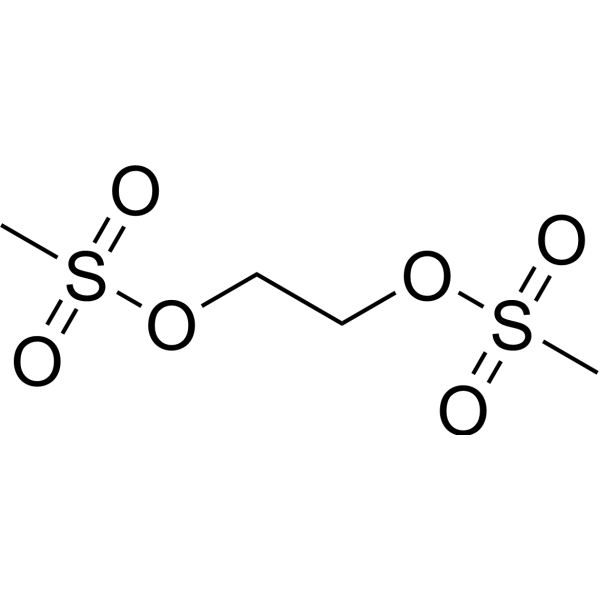Physicochemical Properties
| Molecular Formula | C4H10O6S2 |
| Molecular Weight | 218.25 |
| Exact Mass | 217.992 |
| CAS # | 4672-49-5 |
| Related CAS # | 52410-74-9 |
| PubChem CID | 20796 |
| Appearance | White to off-white solid powder |
| Density | 1.461g/cm3 |
| Boiling Point | 448.9ºC at 760 mmHg |
| Melting Point | 35-36℃ |
| Flash Point | 225.3ºC |
| Index of Refraction | 1.47 |
| LogP | 1.1 |
| Hydrogen Bond Donor Count | 0 |
| Hydrogen Bond Acceptor Count | 6 |
| Rotatable Bond Count | 5 |
| Heavy Atom Count | 12 |
| Complexity | 266 |
| Defined Atom Stereocenter Count | 0 |
| SMILES | CS(=O)(=O)OCCOS(=O)(=O)C |
| InChi Key | QSQFARNGNIZGAW-UHFFFAOYSA-N |
| InChi Code | InChI=1S/C4H10O6S2/c1-11(5,6)9-3-4-10-12(2,7)8/h3-4H2,1-2H3 |
| Chemical Name | 2-methylsulfonyloxyethyl methanesulfonate |
| HS Tariff Code | 2934.99.9001 |
| Storage |
Powder-20°C 3 years 4°C 2 years In solvent -80°C 6 months -20°C 1 month |
| Shipping Condition | Room temperature (This product is stable at ambient temperature for a few days during ordinary shipping and time spent in Customs) |
Biological Activity
| ln Vivo | In rats, sperm granuloma development is caused by ethylene dimethanesulfonate (subcutaneous injection; 75 mg/kg; 7 days) and this interferes with epididymal function [1]. |
| References | [1]. Dutta D, et al. Ethylene dimethane sulfonate (EDS) ablation of Leydig cells in adult rat depletes testosterone resulting in epididymal sperm granuloma: Testosterone replacement prevents granuloma formation. Reprod Biol. 2019 Mar;19(1):89-99. |
Solubility Data
| Solubility (In Vitro) | DMSO : 100 mg/mL (458.19 mM) |
| Solubility (In Vivo) |
Solubility in Formulation 1: ≥ 2.5 mg/mL (11.45 mM) (saturation unknown) in 10% DMSO + 40% PEG300 + 5% Tween80 + 45% Saline (add these co-solvents sequentially from left to right, and one by one), clear solution. For example, if 1 mL of working solution is to be prepared, you can add 100 μL of 25.0 mg/mL clear DMSO stock solution to 400 μL PEG300 and mix evenly; then add 50 μL Tween-80 to the above solution and mix evenly; then add 450 μL normal saline to adjust the volume to 1 mL. Preparation of saline: Dissolve 0.9 g of sodium chloride in 100 mL ddH₂ O to obtain a clear solution. Solubility in Formulation 2: ≥ 2.5 mg/mL (11.45 mM) (saturation unknown) in 10% DMSO + 90% (20% SBE-β-CD in Saline) (add these co-solvents sequentially from left to right, and one by one), clear solution. For example, if 1 mL of working solution is to be prepared, you can add 100 μL of 25.0 mg/mL clear DMSO stock solution to 900 μL of 20% SBE-β-CD physiological saline solution and mix evenly. Preparation of 20% SBE-β-CD in Saline (4°C,1 week): Dissolve 2 g SBE-β-CD in 10 mL saline to obtain a clear solution. Solubility in Formulation 3: ≥ 2.5 mg/mL (11.45 mM) (saturation unknown) in 10% DMSO + 90% Corn Oil (add these co-solvents sequentially from left to right, and one by one), clear solution. For example, if 1 mL of working solution is to be prepared, you can add 100 μL of 25.0 mg/mL clear DMSO stock solution to 900 μL of corn oil and mix evenly. (Please use freshly prepared in vivo formulations for optimal results.) |
| Preparing Stock Solutions | 1 mg | 5 mg | 10 mg | |
| 1 mM | 4.5819 mL | 22.9095 mL | 45.8190 mL | |
| 5 mM | 0.9164 mL | 4.5819 mL | 9.1638 mL | |
| 10 mM | 0.4582 mL | 2.2910 mL | 4.5819 mL |
